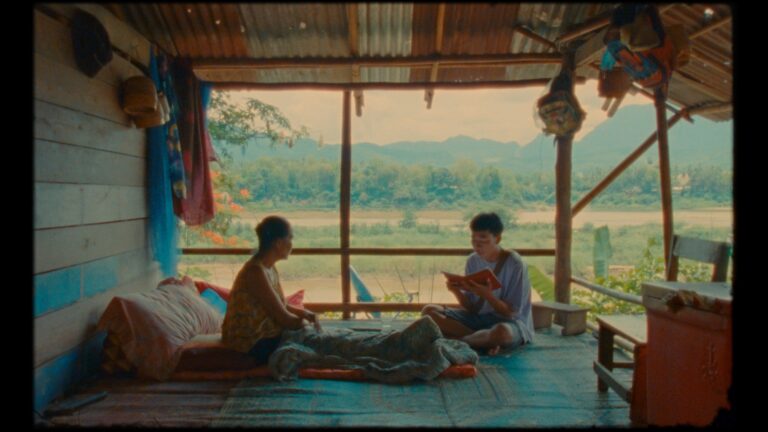
Debuting this week as part of the New Look showcase at New York’s Museum of the Moving Image, Samsara is an impressive new film by Spanish director Lois Patiño. As I watched it, I could not help but think of Alfred, Lord Tennyson’s poem “Crossing the Bar” with its depiction of death as a passage “from out our bourne of Time and Place” into the “boundless deep” of the ocean. Though Tennyson was writing from the point of view of a Christian poet in Victorian-era England, his poem echoes Buddhist and Islamic cosmologies, which provide the framework for this unconventional and exquisitely wrought film.
I say “unconventional” because the director enjoins viewers to close their eyes and slip into a meditative state for about fifteen minutes midway through the film to experience, if only vicariously, the death of one of its elderly characters and her transition to enlightenment. (I must admit to being one of the unenlightened ones, for I could not resist peeking at the screen for fear of missing something.)
The first half of Samsara takes place in Laos, focusing on a group of young saffron-clad boy-novices in a Buddhist monastery, where they transcend time and place in amusingly contemporary ways, such as by pulling out their cell phones after their meditation sessions. One of the teen-aged novices, Amid, is tasked with visiting Mon, an elderly woman on her deathbed, where he reads to her from the Tibetan Book of the Dead to assist her in her final moments upon earth.
It is upon her death that Patiño invites viewers to close their eyes and meditate on her passage from this life to the next, via a liminal state known as bardo. Since I could not resist peeking, I can report that the screen goes black, erupting sporadically into a dazzling phantasmagorical light show that is meant to mirror Mon’s transition from her earthly “bourne of Time and Place” into eternity.
Lois Patiño explains it this way: “One of the key concepts of the Bardo Thodol book is to recognize all light as your own light, all sound as your own sound. In this film, it goes deeper, in the sense that we are connecting very different cultures with this idea of a soul travelling from one body to another. In a sense, it’s a small attempt to bring more fraternity, and I think that’s a good thing to try to produce.”
When the light show has run its course, viewers have been seamlessly transported to a fishing village in Tanzania, where its Muslim women inhabitants are engaged in seaweed gathering and soap making. A baby goat has just been born. The implication, of course, is that Mon’s “soul” has been transferred to the animal—but not in the conventionally understood fashion of a human somehow getting trapped inside a four-legged creature. It is clear that Patiño is quietly acknowledging some simple yet profound truth about the nature of reality as he sees it: that all things are one, part of an infinite reservoir.
Patiño puts it this way: “In Samsara, I continue to work from the Freudian concept of the ‘oceanic feeling’: to be feeling as part of the whole, as the drop of water is an indivisible part of the ocean; an idea of spiritual communion also present in the concept of Buddhist Enlightenment that the project explores. In Samsara, I wanted to take this ‘emptying’ of the image one step further and explore more deeply the idea and representation of the invisible in cinema. That’s when the idea came up to make a film which should be watched with your eyes closed. I wanted the cinematic experience to be closer to the meditative one, and for the theatre to become a space for collective meditation.”
Neither speeches nor scholarly explanations are needed. Samsara is remarkable for its utter lack of proselytizing or heavy-headed explication. Instead, this film is a calm and tranquil experience that enjoins us to “be silent and exult”–to borrow a phrase from Yeats. Everything we need to know about the universe is present if we but pay mindful attention to the recurring rhythms of life, even in a remote village.
Rating: A
Check out more of Edward’s articles.

